2.1.5 biological membranes
1/34
There's no tags or description
Looks like no tags are added yet.
Name | Mastery | Learn | Test | Matching | Spaced |
|---|
No study sessions yet.
35 Terms
what are biological membranes
-all cell and organelle membranes are composed of a phospholipid bilayer
-provide a partially permeable membrane, are the site of chemical reactions and have a role in cell communication (at surface)
-they compartmentalise fro different conditions, separate nucleus, protects cell form contents of lysosomes (within cell)
fluid mosaic model
-it's the mixture and movement of molecules like phospholipids, proteins (can be extrinsic or intrinsic), glycoproteins, glycolipids that the membrane is made of
-phospholipids align as a bilayer due to hydrophilic heads being attracted to water, FACE OUTWARDS and hydrophobic tails being repelled by water
-fluid as components can move around within it
-7-9nm thick

role of channel proteins
-they form tubes filled with water than enable water soluble ions, that CANT diffuse through phospholipid bilayer, to diffuse through
-open in centre, can be gated
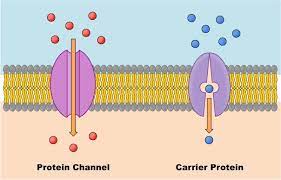
role of carrier proteins
-they bind to other ions and larger molecules, like glucose and amino acids, and change shape to transport them to other side of membrane
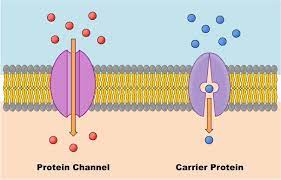
role of cholesterol
-it's a lipid, regulates membrane fluidity
-present in some membranes and restricts lateral movement of other molecules in the membrane
-it's useful as it makes the membrane less fluid at high temperatures and prevents water and dissolved ions leaking out of the cell
-makes membrane fluid when temperature gets too low
-binds hydrophobic tails
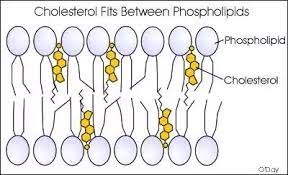
How does temperature affect membrane structure and permeability?
-high temperatures increase kinetic energy of phospholipids, making them move more
-this increases fluidity of membrane , increasing permeability so structure starts to break
-meaning its easier for particles to cross membrane
-high temperatures can denature carrier and channel proteins
How do solvents affect membrane structure and permeability?
-organic solvents, like alcohol, can dissolve phospholipid bilayer
-organic solvents are less polar than water
-disrupt cell
-this damage causes the fluidity and permeability of the membrane to increase
What are the modes of transport in and out of cells?
-simple diffusion
-facilitated diffusion
-osmosis
-active transport
-endocytosis
-exocytoais
simple diffusion
-the net movement of molecules from an area higher concentration to an area of lower concentration, down a concentration gradient, until equilibrium is reached.
-no ATP required
-molecules must be small and lipid soluble and non-polar to diffuse across a membrane
-e.g. O2 and CO2
fascilitated diffussion
-a passive process, down a concentration gradient, through proteins
-the movement of ions and polar molecules can be transported across a membrane by channel and carrier proteins
osmosis
-the movement of water from an area of higher water potential to an area of lower water potential across a PARTIALLY PERMEABLE membrane
active transport definition
-the movement of molecules and ions from an area of lower concentration to an area of higher concentration, against the concentration gradient, using ATP and carrier proteins
-this is selective, only certain molecules can bind to the receptor site on carrier proteins
endocytosis
-active transport/bulk transport of molecules into cells
-cell surface membrane bends inwards to surround molecule, forming a vesicle
-the vesicle pinches off and moves within the cytoplasm
-endocytosis can be classed as phagocytosis, when a solid moves in, or pinocytosis, when a liquid particle moves in
-this requires energy from ATP for cell to engulf and change shape around material
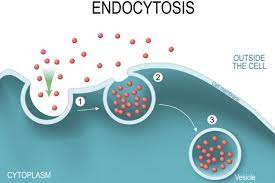
exocytosis
-active transport/bulk transport of molecules out of cell
-vesicles moves towards cell surface membrane along cytoskeleton (requires energy), fuses with membrane and the content of the vesicle is released outside of cell
-requires energy from ATP for vesicle to move along cytoskeleton
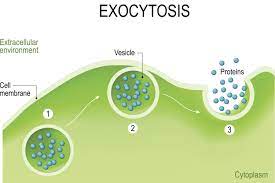
What are the role of membranes within and at the surface of cells?
-site for biochemical reactions
-site of cell communication/cell signalling
-isolating organelles from cytoplasm (compartmentalisation)
-allows cell to change shape
-cover surfaces of cell and surround organelles
-a partially permeable barrier
-forms vesicles
what makes phospholipids amphipathic
-polar phosphate head, hydrophilic
-non-polar fatty acid tail, hydrophobic
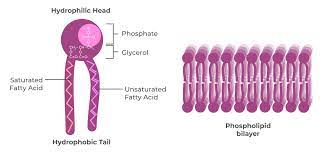
what makes cholesterol amphipathic
-hydroxyl group makes head polar and attracted to phospahte head on phospholipid
-non-polar tail attracted to fatty acid tail
-it has carbon rings, meaning cholesterol is a steroid
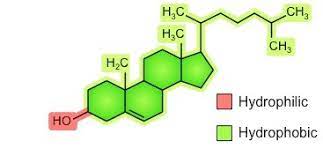
role of phospholipids
-outer surface interacts with water
-barrier to large polar molecules
-allows entry of small non-polar molcules
role of intrinsic/integral proteins
-carrier /channels for ions, sugars, amino acids that can't diffuse across a membrane (polar molecules)
role of extrinsic/peripheral proteins
-found on extracellular side of membrane
-act as receptors in cell recognition (membrane-bound receptors), sites where complementary hormones and drugs can bind
-some are glycoproteins/glycolipids
role of glycoproteins
-extrinsic proteins with attached carbohydrate chains
-involved in cell adhesion and act as receptors for chemical signals, elicits response in cell
-involved in cell signalling and recognition
role of glycolipids
-lipids with attached carbohydrate chains
-they are called antigens, can be recognised by cell's immune system as self/non-self
G-coupled receptor proteins
- neurotransmitter/hormone binds to extracellular domain
-G-protein releases
ligand-gated channel proteins
-as ligand/neurotransmitter binds to receptor, a gate opens so ion can move into cell
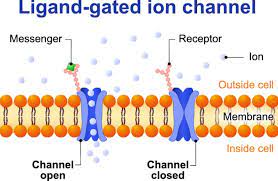
cotransporter proteins
-such as those moving sucrose into companion cell
importance of membrane fluidity for cell
-diffusion of substances across a membrane
-membranes to fuse
-cells to move and change shape
how do typed of fatty acids affect membrane fluidity
-longer fatty acids chains decrease fluidity
-saturated fatty acids decrease fluidity, they create a well-structured arrangement of hydrocarbons
-unsaturated are spaced apart
what particles can’t diffuse through membrane by simple diffussion?
-ions because they're too ionic
-large polar molecules (glucose and amino acids)
passive and active transport
-passive is when no metabolic energy is expended, e.g. diffusion (energy comes from kinetic energy of particles)
-active requires ATP, e.g. active transport and bulk transport
what increases rate of diffusion
-higher temperature, increases kinetic energy of particles
-higher surface area
-increase in concentration gradient
-shorter diffusion distance
-number of channel proteins present (only for fasciliated diffusion)`
steps of active transport
-molecule/ion binds to carrier protein
-ATP will bind to the carrier protein on the inside of the membrane and is hydrolysed into ADP and Pi
-this causes the protein to change shape and open towards the inside of the membrane
-this causes the molecule to be released on the other side of the membrane
-the Pi molecule is then released from the protein, causing it to revert to its original shape
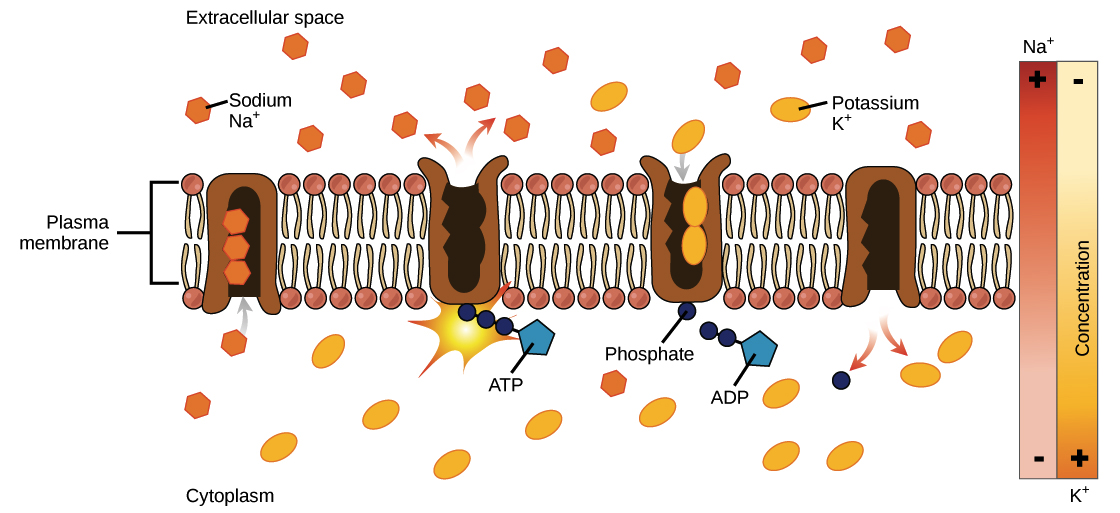
receptor mediated endocytosis
water potential
-pure water has the highest water potential (0)
-the tendency of free water molecules to move in a system
water potential effect on plant cells
hypotonic, higher water potential outside cell, water moves in, vacuole swells, pushes against cell wall, cell is turgid
-hypertonic solution: membrane pulls away form wall, cell becomes flaccid (plasmolysis)
water potential effect on animal cells
-higher water potential outside cell (hypotonic solution), cell swells and bursts
-hypertonic solution, lower water potential, cel shrinks, net movement of water out of cell